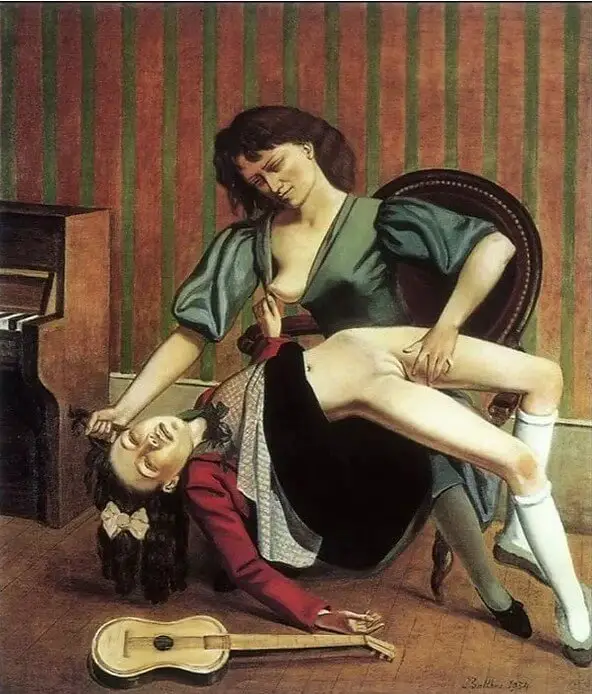“The Guitar Lesson” is an enthralling and enigmatic work by renowned Polish-French artist Balthus (1908-2001). Today we will delve into the depths of this thought-provoking painting, investigating its themes, symbolism, and controversies.
Who is Balthus, and what is his style?
Balthus, born Balthasar Klossowski de Rola, was a 20th-century painter best known for his figurative work. His distinct style blended traditional and modern techniques, frequently depicting subjects in a dreamlike and introspective manner. Balthus was well-known for his meticulous attention to detail and ability to capture the nuances of human emotion.

What Is the Backstory to “The Guitar Lesson”?
“The Guitar Lesson” depicts a young girl receiving a guitar lesson from a woman in a confined space. The painting has a tense atmosphere because the girl appears disinterested, even resistant, while the teacher tries to instruct her. The painting’s specific narrative details remain somewhat ambiguous, leaving room for personal interpretation and speculation.

What Symbolic Elements Appear in “The Guitar Lesson”?
Balthus’ painting is densely packed with symbolism, beckoning viewers to delve deeper into its layers of meaning. Among the key symbolic elements are:
The Guitar: The guitar is a powerful symbol that represents the transformative power of art as well as the potential for creative expression. It functions as a metaphor for self-discovery and personal growth.
The Teacher-Student Relationship: The young girl’s strained relationship with her teacher raises questions about the dynamics of power, control, and the pursuit of artistic mastery. It delves into themes such as resistance, submission, and the complexities of mentorship.
The Interior Setting: The confined space in which the lesson takes place contributes to a sense of claustrophobia and tension. It represents the constraints and limitations placed on individuals in both artistic and societal contexts.
What are the debates surrounding “The Guitar Lesson”?
Because of its controversial subject matter, “The Guitar Lesson” has garnered attention and sparked debate. Some of the issues raised by the painting include:
Concerns have been raised about the sexualization of minors in art due to the depiction of a young girl in a vulnerable position. Some critics argue that Balthus’ portrayal is exploitative or voyeuristic.
The power dynamics between teacher and student have also been interpreted, with some seeing it as an allegory for abuse or manipulation.
Balthus’s body of work, including “The Guitar Lesson,” has been criticised for its depiction of young girls and the potential for it to perpetuate harmful narratives or objectification.
“The Guitar Lesson” by Wolfgang Balthus is a complex and thought-provoking work that continues to captivate audiences with its themes, symbolism, and inherent controversies. The painting explores concepts of power, artistic expression, and the human condition through symbolic elements. While it has sparked debates and raised legitimate concerns about the portrayal of minors in art, “The Guitar Lesson” remains an important piece in Balthus’s oeuvre, inviting viewers to engage in critical dialogue about art, ethics, and interpretation. We can deepen our understanding of Balthus’ intentions and contribute to a meaningful conversation about art and its impact on society by appreciating the work in its historical and artistic context.






















